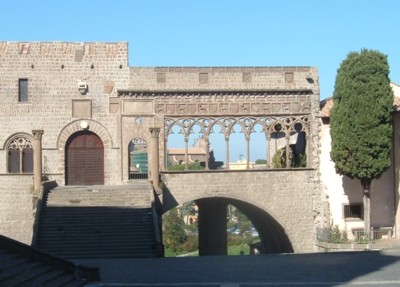Viterbo is in central Italy, to the north of Rome. The town offers many reminders of its medieval past, and lies within an area rich in Etruscan archaeology.
Practical information
The most successful period of Viterbo’s history took place in the Middle Ages, when the town was a residence of the popes. Most of Viterbo’s sights worth seeing date to this golden age. For more about Viterbo’s history, and general information about the area and how to get there, visit our introductory page: About Viterbo.
Where to start
We’d recommend you start your tour of Viterbo at one of the town’s tourist information offices. We found the provincial tourist information office by the Porta Romana railway station to be very well-stocked with maps and guides in English. The office in the centre of town (run by the town rather than Province) was less helpful and could only sell us a guidebook in Italian. When you plan your visit, bear in mind that these offices, and many of the tourist sights, close for several hours in the middle of the day. As elsewhere in Italy, most tourist attractions close on a Monday – in Viterbo you can still visit the Cathedral and the Palazzi Comunali.
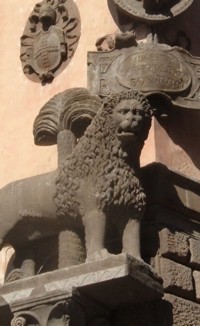
Major tourist sights
Apart from the churches which are dotted around Viterbo, the town’s sights tend to be concentrated around two squares: Piazza del Plebiscito, the municipal heart of town, and Piazza San Lorenzo, the religious centre. The two are not far apart, and it’s easy to explore central Viterbo on foot.
Palazzo dei Papi
Located in the attractive Piazza San Lorenzo, the Palazzo dei Papi or Palazzo Papale (Papal Palace) is a striking reminder of this town’s former importance. Built between 1255 and 1267 to house the popes who had sought refuge in Viterbo, its most striking feature is an elegant seven-arched loggia. The small courtyard behind these interlocking arches is also pretty, with a lion-bedecked fountain and views out towards the city walls.
One of the best stories about the Viterbo popes is of an election for the papacy in 1268. 18 cardinals dutifully assembled in the bishop’s palace, but after a year and a half they still hadn’t managed to choose between candidates. The Viterbesi, exasperated, locked the cardinals in their conclave (the word comes from the Latin ‘with key’), reduced them to bread and water rations and even removed the roof of the palace. Eventually the cardinals made their decision, but it had taken nearly three years – the longest ever conclave.
Most of the palace is not open to the public. The loggia is usually open in the mornings (except Thursdays). You can visit the papal election hall (Salone or Aula del Conclave), by request through the Museo del Colle del Duomo.
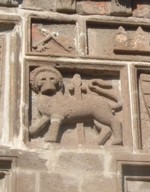
Cattedrale di San Lorenzo
Viterbo’s cathedral is dedicated to one of the town’s two patron saints, St Laurence (the other is Rosa, the focus for the town’s biggest religious festival). The campanile shows striped Tuscan/Umbrian influences. The cathedral was badly damaged by Allied bombing in 1944, and the roof and nave were subsequently rebuilt to an earlier design. The interior is lofty and simple. Highlights include a fine tiled floor, an ornate fifteenth-century font and fragmentary fourteenth-century frescoes (in the first chapel on the right). Look out for a plaque recording the spot where the body of one ‘Enrico di Cornovaglia’ was temporarily buried in 1271. Henry, son of Richard, Earl of Cornwall was attending the Papal court in Viterbo when he was murdered (in the church of San Silvestro) by his de Montfort cousins.
Next door, the small Museo del Colle del Duomo (Cathedral hill museum) has displays of the cathedral’s relics and treasures: paintings, vestments and many reliquaries. Look out for a sixteenth-century reliquary which claims to contain the chin of St. John the Baptist (San Giovanni Battista), surely one of the most popular and widely-distributed of all saints. The museum is closed at lunchtimes.
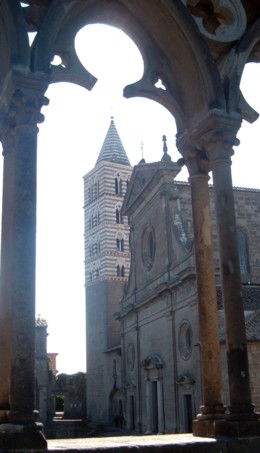
Palazzi Comunali: Palazzo dei Priori and Palazzo del Podestà
The two connected buildings of the Palazzo dei Priori and Palazzo del Podestà dominate Piazza del Plebiscito. These have been the centre for the town’s civic authorities for centuries, and can be visited by the public. Through the ornate archway on the main piazza is a small panoramic courtyard containing one of Viterbo’s many fine sculptured fountains, an arcade and some Etruscan sarcophagus lids. The main weekday entrance to the complex of the Palazzo Comunali is just downhill from the main square. A number of grand rooms can be visited, including a seventeenth-century chapel and the Sala Regia which is decorated with sixteenth-century frescoes illustrating myths and histories of Viterbo. Open 9am-1pm (from 10am on Sundays) and 3pm-6.30pm.
Museo Nazionale / Rocca Albornoz
The Rocca Albornoz is a fortress originally built in the fourteenth century for the Spanish Cardinal Albornoz. Today it houses the Museo Nazionale, which contains displays about Etruscan architecture (with reconstructions) and statues from the Roman town of Ferento. Closed Mondays.
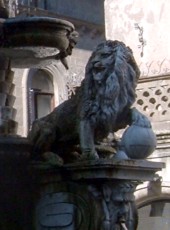
Museo Civico
If you are carrying out an in-depth exploration of this area of Italy, it’s worth visiting the town museum in Piazza Crispi (9am-7pm daily except Mondays). In the archaeological section you will find sarcophagi and grave goods from the Etruscan era as well as later Roman finds. Also on display are fake antiquities created in the fifteenth century by Annius of Viterbo, a monk and forger who attempted to create fictitious histories for the town. The museum also has medieval and artistic collections with a range of exhibits from Viterbo’s past, from panels by Sebastian del Piombo to sketches for the Macchina di Santa Rosa (see our Viterbo information page for more on this local tradition).
Other things to see
From one of the town’s tourist offices you should be able to pick up a guide detailing Viterbo’s numerous historic churches. These include the eleventh-century Chiesa di San Silvestro, in Piazza del Gesù, scene of the murder of Henry of Cornwall (see above) which contains a plaque remembering the event and some fifteenth century frescoes. The town’s minor museums include a ceramics museum and another devoted to the Macchina di Santa Rosa (this is located on Via di San Pellegrino and has limited opening hours; check the website of the Sodalizio dei Facchini di Santa Rosa).
Visitors wandering around the town’s pretty medieval areas will notice that, as well as churches, Viterbo boasts a large number of fountains, some of which are very grand. If you are travelling with children, they might enjoy spotting the multitude of stone lions prowling around the city. Viterbo’s emblem, the lion appears on fountains, walls, street-corners and churches. There is an impressive variety of beasts to be spotted, from the ferocious to the timid.
> About Viterbo: background and practical advice for visitors
> Viterbo hotels, B&Bs and apartments
Useful external links
Lazio destinations
- About the Lazio region
- Anzio
- Bracciano
- Calcata
- Castel Gandolfo
- Castelli Romani
- Cerveteri
- Formia
- Frascati
- Gaeta
- Palestrina
- Pontine islands
- Ponza
- Rome
- Sperlonga
- Terracina
- Tivoli
- Ventotene
- Viterbo
